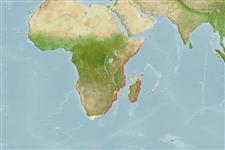>
Ovalentaria/misc (Various families in series Ovalentaria) >
Ambassidae (Asiatic glassfishes)
Etymology: Ambassis: Derived from Greek, anabasis = climbing up (Ref. 45335).
More on authors: Gilchrist & Thompson.
Environment: milieu / climate zone / depth range / distribution range
Ecología
marino; agua dulce; salobre demersal. Subtropical; 13°N - 39°S, 19°E - 52°E
Western Indian Ocean: East coast from KwaZulu-Natal south to Algoa Bay in South Africa (Ref. 4318, 7248, 52193). Reported from east Africa (Ref. 4318), including Madagascar (Ref. 4180, 50956) and Mauritius (Ref. 50956).
Length at first maturity / Tamaño / Peso / Age
Maturity: Lm 3.5 range ? - ? cm
Max length : 10.0 cm SL macho / no sexado; (Ref. 52193)
Short description
Claves de identificación | Morfología | Morfometría
Espinas dorsales (total) : 8; Radios blandos dorsales (total) : 9 - 11; Espinas anales: 3; Radios blandos anales: 9 - 11. Diagnosis: Ambassis natalensis has following combination of characters: supraorbital spines 1-4; rostral spine absent; rear margin of preopercle entirely serrate; preopercle ridge smooth except for 1-5 tiny spines at rear corner; interopercle smooth or with 1-4 tiny serrae at angle; two rows of cheek scales; predorsal scales 9-11; lateral line continuous; lower gill rakers 19-22; pectoral-fin rays 14-15; teeth on vomer and palatines in 2-3 rows (Ref. 50956).
Tolerant of freshwater within a temperature range of 19-27°C (Ref. 4180, 52193, 79840). In summer, it feeds mainly in early evening and late morning while in winter, it feeds both day and night on crustaceans as well as insects (aquatic and terrestrial) and fish (Ref. 7248, 52193). Excellent subject for biological research as it easily thrives in captivity (Ref. 12484).
Life cycle and mating behavior
Madurez | Reproducción | Puesta | Huevos | Fecundidad | Larva
Maugé, L.A., 1986. Ambassidae. p. 297-298. In J. Daget, J.-P. Gosse and D.F.E. Thys van den Audenaerde (eds.) Check-list of the freshwater fishes of Africa (CLOFFA). ISNB, Brussels; MRAC, Tervuren; and ORSTOM, Paris. Vol. 2. (Ref. 4180)
IUCN Red List Status (Ref. 130435: Version 2024-1)
Threat to humans
Harmless
Human uses
Pesquerías: sin interés; Acuario: Comercial; carnada: usually
Herramientas
Special reports
Download XML
Fuentes de Internet
Estimates based on models
Preferred temperature (Ref.
123201): 23.9 - 27.6, mean 26.7 °C (based on 82 cells).
Phylogenetic diversity index (Ref.
82804): PD
50 = 0.5000 [Uniqueness, from 0.5 = low to 2.0 = high].
Bayesian length-weight: a=0.01413 (0.00731 - 0.02730), b=3.02 (2.85 - 3.19), in cm total length, based on LWR estimates for this species & Genus-body shape (Ref.
93245).
Nivel trófico (Ref.
69278): 3.4 ±0.59 se; based on food items.
Resiliencia (Ref.
120179): Alto, población duplicada en un tiempo mínimo inferior a 15 meses (Assuming Fec > 10,000).
Fishing Vulnerability (Ref.
59153): Low vulnerability (10 of 100).
